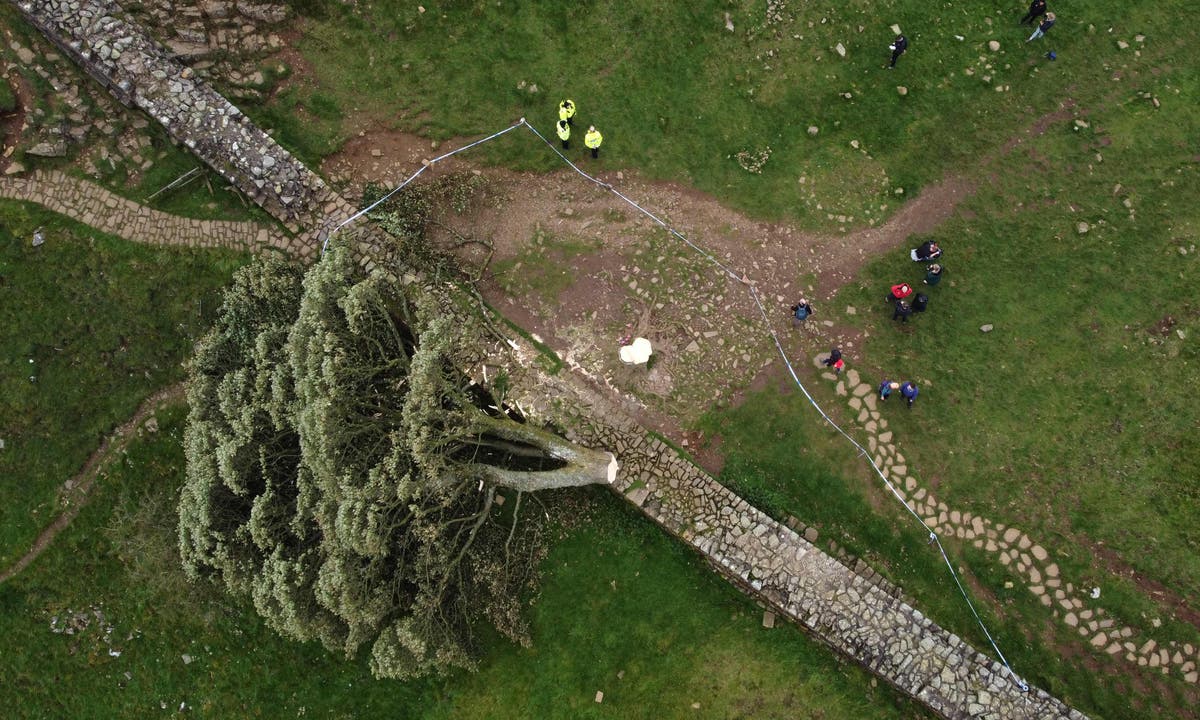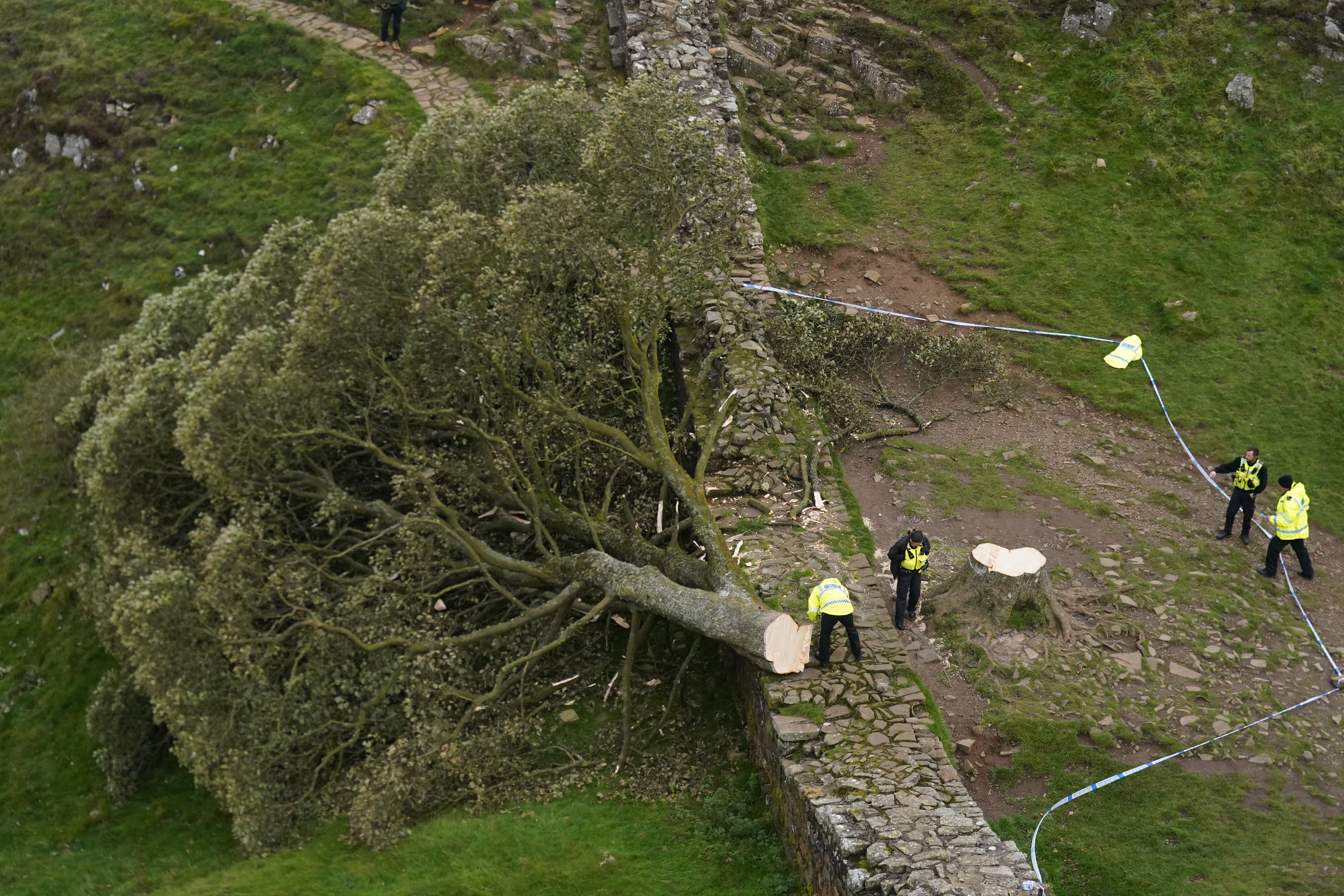Sycamore Gap tree - latest: Man pleads not guilty to charges as damage valued at more than £620,000
The tragedy of the felled tree - which dated back to medieval times - caused national outrage in September
Two men have appeared in court in connection with the felling of the Sycamore Gap tree - which has been valued at £620,000 in criminal damage.
Daniel Graham, 38, and Adam Carruthers, 31, have been charged with causing the damage, the Crown Prosecution Service said. They are on bail.
Graham entered pleas of not guilty, while Carruthers entered no plea when they appeared on Wednesday.
There was a national outcry in September when the much-loved, centuries-old tree in rural Northumberland was found to have been cut down.
The tree, believed to have been one of the most photographed in the country, used to sit in a gap along Hadrian’s Wall – a Unesco world heritage site – and a popular hotspot for tourists and walkers.
Its origins are believed to have dated back to medieval times and it has been excavated on two previous occasions – between 1908 and 1911 and again between 1982 and 1987 – when Roman remains linked to Hadrian’s Wall were found.
Northumberland National Park (NNP) said it had received 2,000 “heartfelt” messages from people from all around the world expressing sadness and that it had been inundated with offers of help.
Court sketch shows two men accused in connection with the felling of the Sycamore Gap tree
Daniel Graham, 38, (left)of Milbeck Stables, Carlisle, and Adam Carruthers, 31, of Church Street, Wigton, Cumbria, appeared in the dock at Newcastle Magistrates’ Court on Wednesday.
They are accused of causing £622,191 worth of damage to the much-photographed Sycamore Gap tree.

A man accused of felling the famous Sycamore Gap tree has denied charges of criminal damage.
Daniel Graham, 38, and Adam Carruthers, 31, appeared at Newcastle Magistrates’ Court on Wednesday.
Graham, of Milbeck Stables, Carlisle, entered pleas of not guilty, while Carruthers, of Church Street, Wigton, Cumbria, entered no pleas.
The pair are charged with criminal damage to property of a value over £5,000, namely “without lawful excuse, damaged a sycamore tree to the value of £622,191 belonging to the National Trust”.
They face a second charge of criminal damage to property valued under £5,000, namely Hadrian’s Wall, with the damage assessed to the Unesco World Heritage Site as being £1,144.
Both offences were alleged to have been committed on September 28 last year.
Loss of Sycamore Gap tree caused ‘serious distress’, court hears
During the hearing, Rebecca Brown, prosecuting, said that the tree was “instantly recognisable”.
She said the cost of the damage to the tree was assessed using the Capital Asset Value for Amenity Trees (CAVAT) tool used by local authorities to work out the level of compensation needed to replace a tree.
Ms Brown said factors involved in the calculation involved the size of the tree, its type and the number of people who had access to it.
The lawyer said the loss of the tree had caused “serious distress”, as well as economic and social damage.
The case was “complex” and involved cell site analysis, number plate recognition technology, botany, evaluation of the tree and “image enhancement”, she said.
Sycamore Gap tree given new life at top-secret lab
In case you missed this piece from March:
Shoots from the rescued seeds and twigs of the Sycamore Gap have sprung up in a secret National Trust laboratory, fuelling hopes the iconic tree will regrow after it was cut down with a chainsaw.
Scientists acted fast, grabbing young cuttings thrown to the ground when the tree fell before whisking them off to a high-security Devon greenhouse guarding genetic copies of the UK’s most precious plants.
Five months on in the lab which keeps its exact location shrouded in mystery, tiny shoots are regrowing with nine grafted plants and 50 seedling clones that could be used as back-up in case the stump doesn’t regrow naturally.

Sycamore Gap tree given new life at top-secret lab
The Sycamore Gap tree was chopped down illegally six months ago – but today, there are reasons to be hopeful with new life springing from cuttings from the famous tree
Sycamore Gap tree damage valued at more than £620,000, charges show
The criminal damage caused by felling the famous Sycamore Gap tree has been valued at more than £620,000, according to court charges.
The much-photographed tree, which stood next to Hadrian’s Wall in Northumberland for 200 years, was chopped down in September last year, causing a national outrage.

‘A sentinel of time’
Many paid tribute to the tree after it was felled, with one woman writing a poem to express her sadness as she described the tree as a “sentinel of time”.
Laura Charlton, said she wrote the poem, an Ode to a Sycamore Tree, to try to capture the “recklessness of the actions and the sense of bereavement the locals are feeling.”
“The birds sing their morning song/Wind dances through the leaves/Almost just as it once was/Yet Northumberland is bereaved,” it read.
Why was the Sycamore Gap tree so significant?
The tree, believed to have been one of the most photographed in the country, used to sit in a gap along Hadrian’s Wall - a UNESCO World Heritage Site - in rural Northumberland and was a popular hotspot for tourists, walkers and others.
It is believed to have dated back to medieval times and has been excavated on two occasions - between 1908 and 1911 and again between 1982 and 1987, when Roman remains linked to Hadrian’s Wall were found.
The sycamore perhaps first became known around the globe after featuring in the film Robin Hood: Prince of Thieves, starring Kevin Costner, Morgan Freeman and Alan Rickman.

Pictures show the two men accused leaving court



Court sketch shows two men accused in connection with the felling of the Sycamore Gap tree
Daniel Graham, 38, (left)of Milbeck Stables, Carlisle, and Adam Carruthers, 31, of Church Street, Wigton, Cumbria, appeared in the dock at Newcastle Magistrates' Court.
They are accused of causing £622,191 worth of damage to the much-photographed Sycamore Gap tree

Loss of Sycamore Gap tree caused ‘serious distress’, court hears
During the hearing, Rebecca Brown, prosecuting, said that the tree was “instantly recognisable”.
She said the cost of the damage to the tree was assessed using the Capital Asset Value for Amenity Trees (CAVAT) tool used by local authorities to work out the level of compensation needed to replace a tree.
Ms Brown said factors involved in the calculation involved the size of the tree, its type and the number of people who had access to it.
The lawyer said the loss of the tree had caused “serious distress”, as well as economic and social damage.
The case was “complex” and involved cell site analysis, number plate recognition technology, botany, evaluation of the tree and “image enhancement”, she said.

Subscribe to Independent Premium to bookmark this article
Want to bookmark your favourite articles and stories to read or reference later? Start your Independent Premium subscription today.

